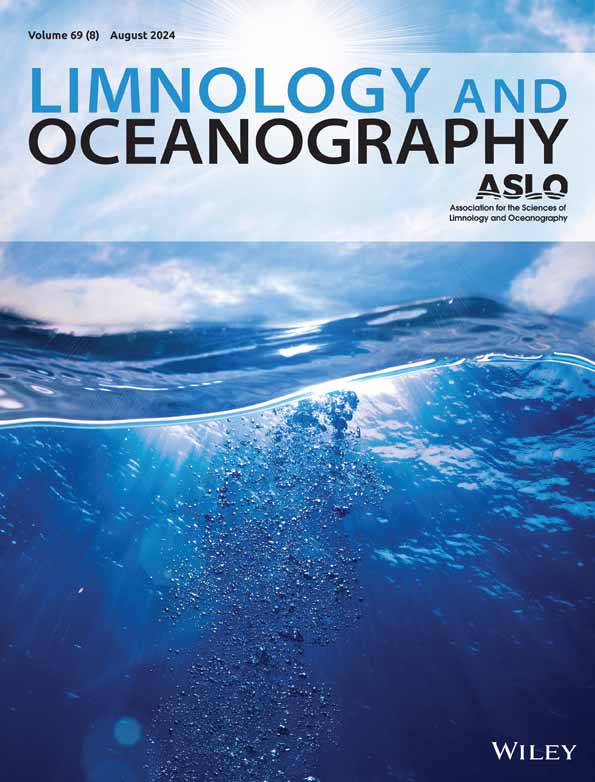底栖生物和潜流生物膜对光有效性和宏量营养素化学计量的功能响应对比
IF 3.7
1区 地球科学
Q1 LIMNOLOGY
引用次数: 0
摘要
源流的营养动态受底栖生物膜和潜栖生物膜的控制,碳(C):氮(N):磷(P)比例通过营养限制驱动异养微生物生物膜的发育。此外,异养对C: N: P比率变化的响应可能受到对光和C: N: P比率的自养响应的调节,这改变了光合分泌物的数量和组成,并增加了对养分的竞争。异养生物膜群落对功能特性的影响,如有机化合物的使用在很大程度上是未知的。我们进行了一项因子设计的中游生态实验,采用不同的C: N: P比率和光照水平,通过底栖生物膜和潜栖生物膜的群落水平生理特征,测试对异养生物膜功能的直接和间接影响。当诱导资源C: N: P比接近异养微生物生物量C: N: P比时,我们发现代谢底物的功能多样性增加,特别是在低渗生物膜中。此外,在早期生物膜中,这种变化使底物倾向于含磷较少的底物和含氮较多的底物。尽管光对潜存生物膜没有直接影响,但我们检测到底栖生物自养效应在潜存生物膜中的传播。光的可用性诱导了潜存细菌密度和酚类化合物、氨基酸和碳水化合物的使用。在底栖生物膜中,只有碳水化合物的使用受到光的影响。这些结果强调了底栖自养生物对低沉微生物异养生物功能的重要间接影响,并表明了人类影响(如养分输入和砍伐)对河流养分循环的影响。本文章由计算机程序翻译,如有差异,请以英文原文为准。
Contrasting functional responses of benthic and hyporheic stream biofilms to light availability and macronutrient stoichiometry
Nutrient dynamics in headwater streams are governed by benthic and hyporheic biofilms, with carbon (C) : nitrogen (N) : phosphorus (P) ratios driving the heterotrophic microbial biofilm development through nutrient limitation. Furthermore, heterotrophic responses to changes in C : N : P ratios are probably modulated by autotrophic responses to light and C : N : P ratios, which modify the amount and composition of photosynthetic exudates and increase competition for nutrients. Effects on functional properties like the use of organic compounds by the heterotrophic biofilm community are largely unknown. We conducted a stream mesocosm experiment with a factorial design with different C : N : P ratios and light availability levels to test direct and indirect effects on heterotrophic biofilm functioning via community‐level physiological profiles in benthic and hyporheic biofilms. When inducing a resource C : N : P ratio closer to heterotrophic microbial biomass C : N : P ratios, we found an increased functional diversity of metabolized substrates, especially in hyporheic biofilms. Furthermore, this alteration shaped substrate preferences toward less P‐containing substrates and more N‐containing substrates in early‐stage biofilms. Despite the absence of a direct impact of light on hyporheic biofilms, we detected a propagation of a benthic autotrophic effect into hyporheic biofilms. Light availability induced effects on hyporheic bacterial density and the use of phenolic compounds, amino acids, and carbohydrates. In benthic biofilms, only the use of carbohydrates was affected by light. These results emphasize the significant indirect effects of benthic autotrophs on the functionality of hyporheic microbial heterotrophs and suggest consequences of human impacts, such as nutrient inputs and clear‐cutting, on stream nutrient cycling.
求助全文
通过发布文献求助,成功后即可免费获取论文全文。
去求助
来源期刊

Limnology and Oceanography
地学-海洋学
CiteScore
8.80
自引率
6.70%
发文量
254
审稿时长
3 months
期刊介绍:
Limnology and Oceanography (L&O; print ISSN 0024-3590, online ISSN 1939-5590) publishes original articles, including scholarly reviews, about all aspects of limnology and oceanography. The journal''s unifying theme is the understanding of aquatic systems. Submissions are judged on the originality of their data, interpretations, and ideas, and on the degree to which they can be generalized beyond the particular aquatic system examined. Laboratory and modeling studies must demonstrate relevance to field environments; typically this means that they are bolstered by substantial "real-world" data. Few purely theoretical or purely empirical papers are accepted for review.
 求助内容:
求助内容: 应助结果提醒方式:
应助结果提醒方式:


